VOLVO XC90 TWIN ENGINE 2018 Manual PDF
Manufacturer: VOLVO, Model Year: 2018, Model line: XC90 TWIN ENGINE, Model: VOLVO XC90 TWIN ENGINE 2018Pages: 686, PDF Size: 17 MB
Page 71 of 686
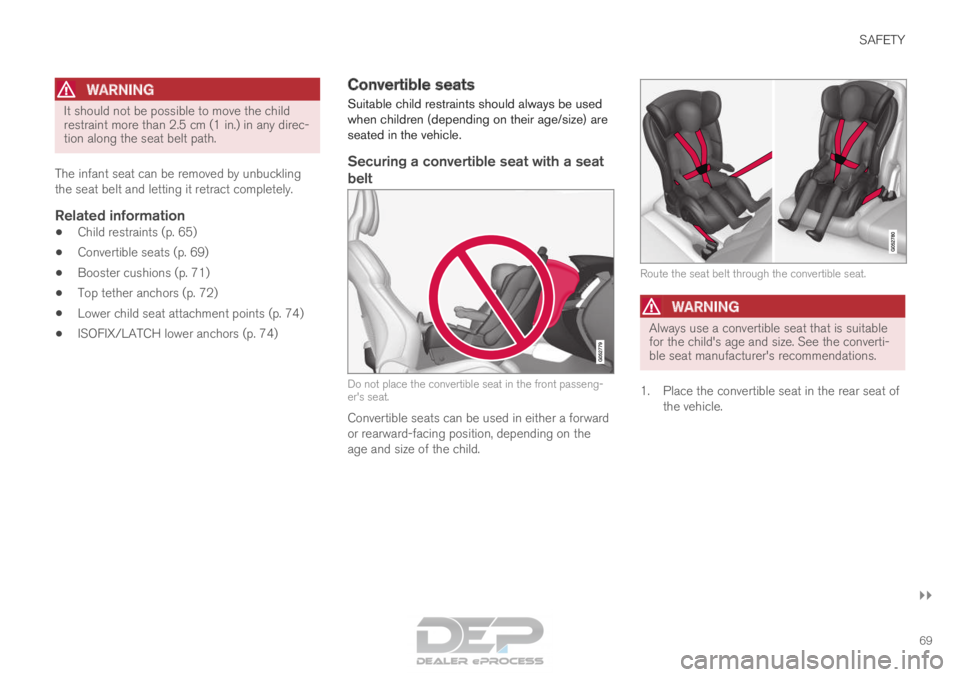
SAFETY
}}69
WARNING It should not be possible to move the child
restraint more than 2.5 cm (1 in.) in any direc-
tion along the seat belt path.
The infant seat can be removed by unbuckling
the seat belt and letting it retract completely.
Related information
• Child restraints (p. 65)
• Convertible seats (p. 69)
• Booster cushions (p. 71)
• Top tether anchors (p. 72)
• Lower child seat attachment points (p. 74)
• ISOFIX/LATCH lower anchors (p. 74) Convertible seats
Suitable child restraints should always be used
when children (depending on their age/size) are
seated in the vehicle.
Securing a convertible seat with a seat
belt Do not place the convertible seat in the front passeng-
er's seat.
Convertible seats can be used in either a forward
or rearward-facing position, depending on the
age and size of the child. Route the seat belt through the convertible seat.
WARNING
Always use a convertible seat that is suitable
for the child's age and size. See the converti-
ble seat manufacturer's recommendations.
1.
Place the convertible seat in the rear seat of
the vehicle.
Page 72 of 686
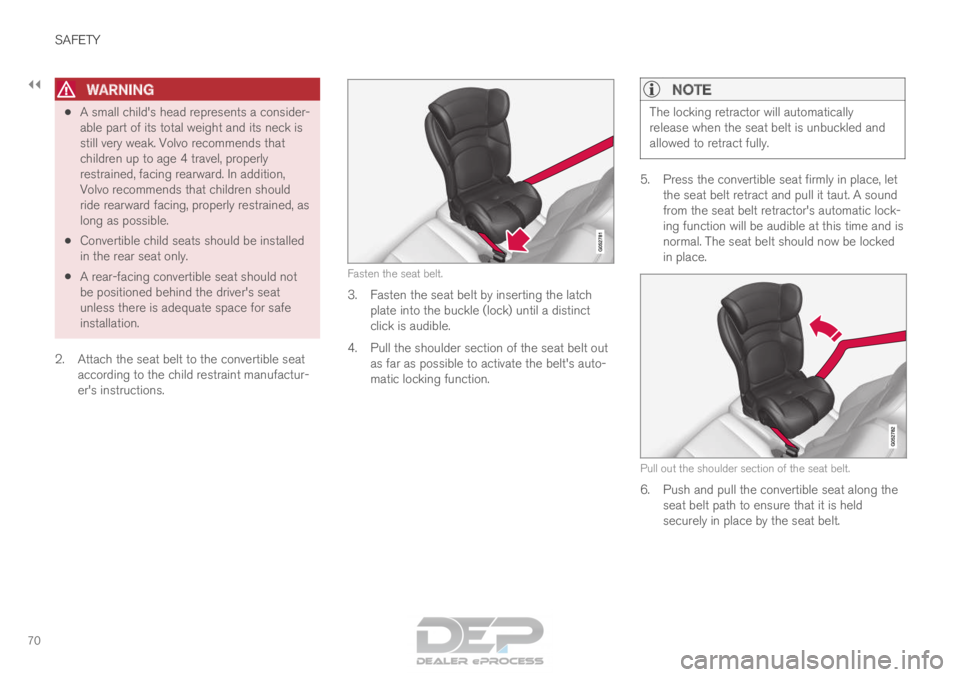
||SAFETY
70
WARNING
•
A small child's head represents a consider-
able part of its total weight and its neck is
still very weak. Volvo recommends that
children up to age 4 travel, properly
restrained, facing rearward. In addition,
Volvo recommends that children should
ride rearward facing, properly restrained, as
long as possible.
• Convertible child seats should be installed
in the rear seat only.
• A rear-facing convertible seat should not
be positioned behind the driver's seat
unless there is adequate space for safe
installation.
2.
Attach the seat belt to the convertible seat
according to the child restraint manufactur-
er's instructions. Fasten the seat belt.
3. Fasten the seat belt by inserting the latch
plate into the buckle (lock) until a distinct
click is audible.
4.
Pull the shoulder section of the seat belt out
as far as possible to activate the belt's auto-
matic locking function.
NOTE The locking retractor will automatically
release when the seat belt is unbuckled and
allowed to retract fully.
5. Press the convertible seat firmly in place, let
the seat belt retract and pull it taut. A sound
from the seat belt retractor's automatic lock-
ing function will be audible at this time and is
normal. The seat belt should now be locked
in place. Pull out the shoulder section of the seat belt.
6. Push and pull the convertible seat along the
seat belt path to ensure that it is held
securely in place by the seat belt.
Page 73 of 686
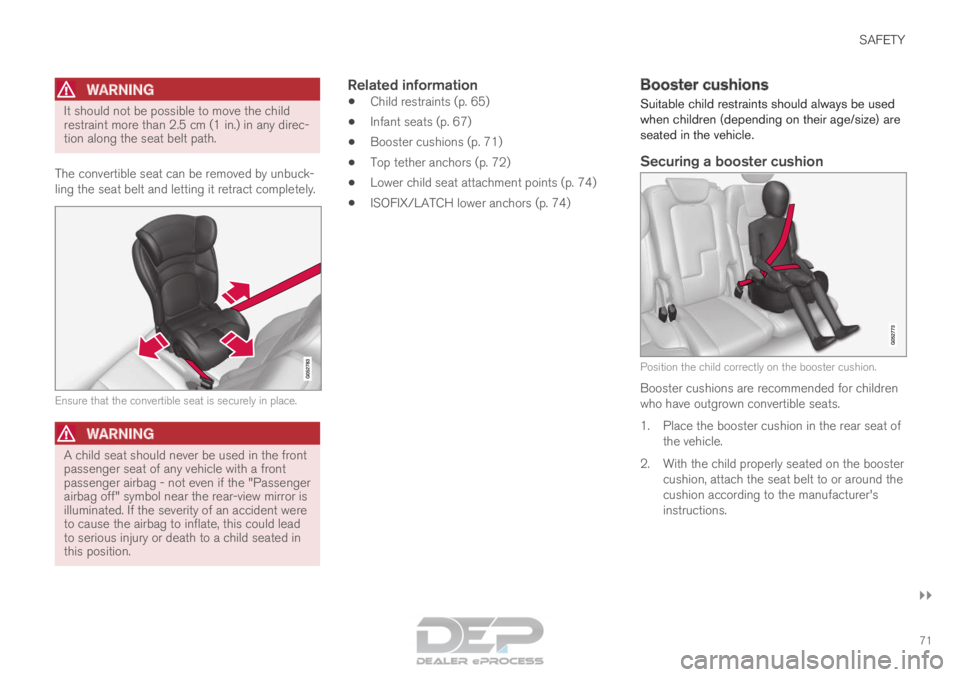
SAFETY
}}71
WARNING It should not be possible to move the child
restraint more than 2.5 cm (1 in.) in any direc-
tion along the seat belt path.
The convertible seat can be removed by unbuck-
ling the seat belt and letting it retract completely. Ensure that the convertible seat is securely in place.
WARNING
A child seat should never be used in the front
passenger seat of any vehicle with a front
passenger airbag - not even if the "Passenger
airbag off" symbol near the rear-view mirror is
illuminated. If the severity of an accident were
to cause the airbag to inflate, this could lead
to serious injury or death to a child seated in
this position.
Related information
•
Child restraints (p. 65)
• Infant seats (p. 67)
• Booster cushions (p. 71)
• Top tether anchors (p. 72)
• Lower child seat attachment points (p. 74)
• ISOFIX/LATCH lower anchors (p. 74) Booster cushions
Suitable child restraints should always be used
when children (depending on their age/size) are
seated in the vehicle.
Securing a booster cushion Position the child correctly on the booster cushion.
Booster cushions are recommended for children
who have outgrown convertible seats.
1.
Place the booster cushion in the rear seat of
the vehicle.
2. With the child properly seated on the booster cushion, attach the seat belt to or around the
cushion according to the manufacturer's
instructions.
Page 74 of 686
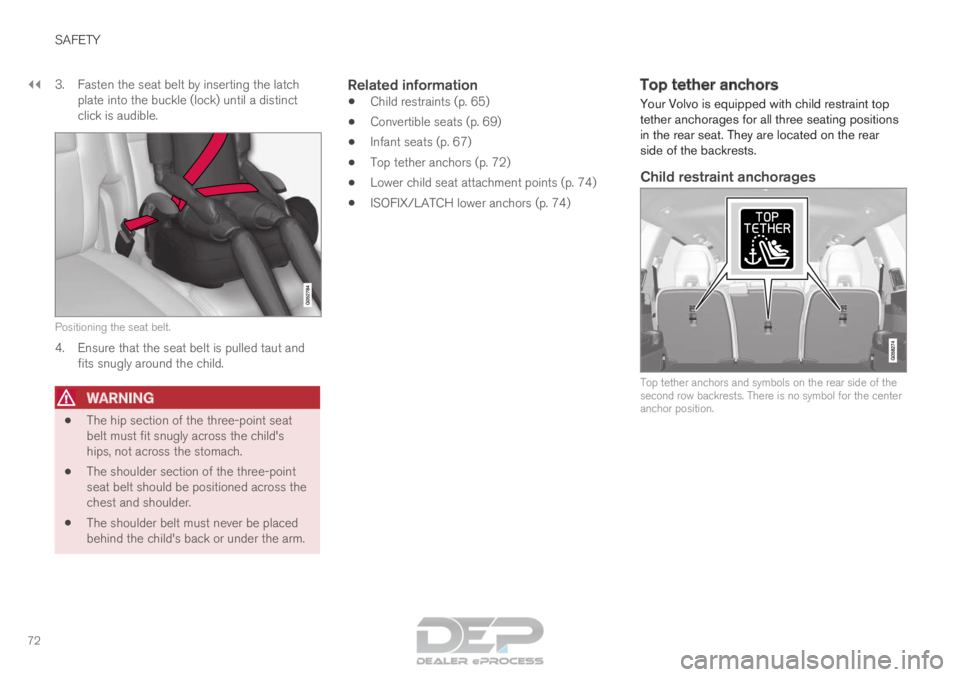
||SAFETY
72
3. Fasten the seat belt by inserting the latch
plate into the buckle (lock) until a distinct
click is audible. Positioning the seat belt.
4. Ensure that the seat belt is pulled taut and
fits snugly around the child.
WARNING •
The hip section of the three-point seat
belt must fit snugly across the child's
hips, not across the stomach.
• The shoulder section of the three-point
seat belt should be positioned across the
chest and shoulder.
• The shoulder belt must never be placed
behind the child's back or under the arm.
Related information
• Child restraints (p. 65)
• Convertible seats (p. 69)
• Infant seats (p. 67)
• Top tether anchors (p. 72)
• Lower child seat attachment points (p. 74)
• ISOFIX/LATCH lower anchors (p. 74) Top tether anchors
Your Volvo is equipped with child restraint top
tether anchorages for all three seating positions
in the rear seat. They are located on the rear
side of the backrests.
Child restraint anchorages Top tether anchors and symbols on the rear side of the
second row backrests. There is no symbol for the center
anchor position.
Page 75 of 686
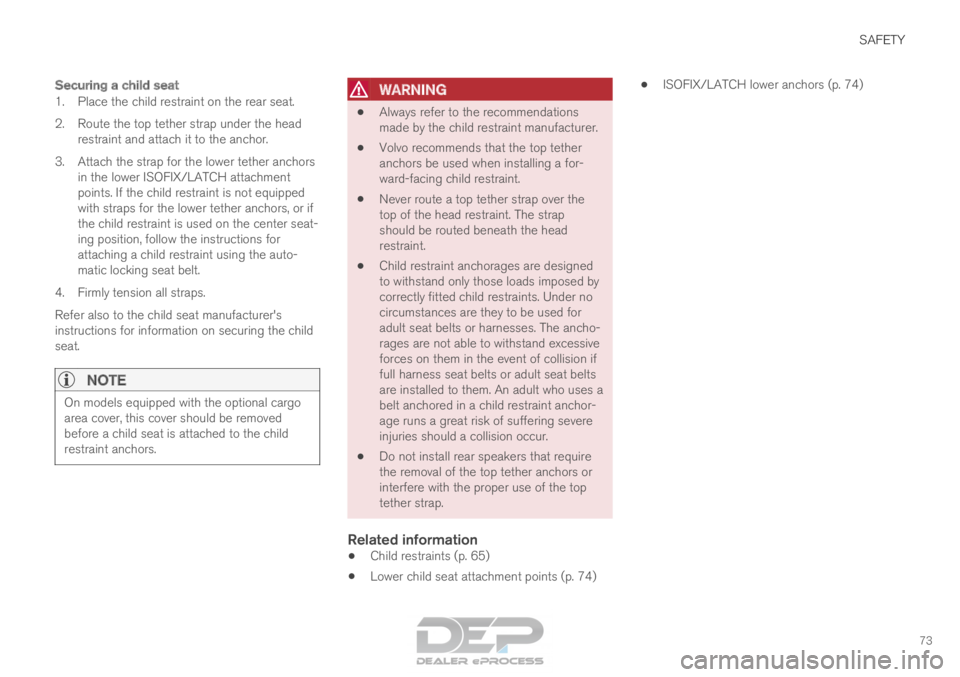
SAFETY
73
Securing a child seat
1. Place the child restraint on the rear seat.
2. Route the top tether strap under the headrestraint and attach it to the anchor.
3. Attach the strap for the lower tether anchors in the lower ISOFIX/LATCH attachment
points. If the child restraint is not equipped
with straps for the lower tether anchors, or if
the child restraint is used on the center seat-
ing position, follow the instructions for
attaching a child restraint using the auto-
matic locking seat belt.
4. Firmly tension all straps.
Refer also to the child seat manufacturer's
instructions for information on securing the child
seat.
NOTE On models equipped with the optional cargo
area cover, this cover should be removed
before a child seat is attached to the child
restraint anchors.
WARNING •
Always refer to the recommendations
made by the child restraint manufacturer.
• Volvo recommends that the top tether
anchors be used when installing a for-
ward-facing child restraint.
• Never route a top tether strap over the
top of the head restraint. The strap
should be routed beneath the head
restraint.
• Child restraint anchorages are designed
to withstand only those loads imposed by
correctly fitted child restraints. Under no
circumstances are they to be used for
adult seat belts or harnesses. The ancho-
rages are not able to withstand excessive
forces on them in the event of collision if
full harness seat belts or adult seat belts
are installed to them. An adult who uses a
belt anchored in a child restraint anchor-
age runs a great risk of suffering severe
injuries should a collision occur.
• Do not install rear speakers that require
the removal of the top tether anchors or
interfere with the proper use of the top
tether strap.
Related information
•Child restraints (p. 65)
• Lower child seat attachment points (p. 74) •
ISOFIX/LATCH lower anchors (p. 74)
Page 76 of 686

SAFETY
74Lower child seat attachment points
The vehicle is equipped with lower child restraint
attachment points in the second row of seats. The lower child seat attachment points are
intended for use with certain rear-facing child
restraints.
Always follow the manufacturer's installation
instructions when attaching a child seat to the
lower child seat attachment points.
Location of child seat attachment
points Location of the child seat attachment points in the sec-
ond row of seats.
The child seat attachment points in the second
row of seats are located on the rear section of
the front seat floor rails.
Related information
• Child restraints (p. 65)
• Top tether anchors (p. 72)
• ISOFIX/LATCH lower anchors (p. 74) ISOFIX/LATCH lower anchors
Lower anchors for ISOFIX/LATCH-equipped
child seats are located in the second row, out-
board seats, hidden below the backrest cush-
ions.
Using the ISOFIX/LATCH lower child
seat anchors Location of the ISOFIX/LATCH anchors
Symbols on the seat back upholstery mark the
ISOFIX/LATCH anchor positions as shown. To
access the anchors, kneel on the seat cushion
and locate the anchors by feel. Always follow your
child seat manufacturer's installation instructions,
and use both ISOFIX/LATCH lower anchors and
top tethers whenever possible.
Page 77 of 686

SAFETY
75
To access the anchors
1. Put the child restraint in position.
2. Kneel on the child restraint to press downthe seat cushion and locate the anchors by
feel.
3. Fasten the attachment on the child restraint's lower straps to the ISOFIX/LATCH
lower anchors.
4. Firmly tension the lower child seat straps according to the manufacturer's instructions.
WARNING Volvo's ISOFIX/LATCH anchors conform to
FMVSS/CMVSS standards. Always refer to
the child restraint system's manual for weight
and size ratings.
NOTE •
The rear center seat is not equipped with
ISOFIX/LATCH lower tether anchors. If a
child restraint is used in this seat, attach
the restraint's upper anchor strap (if
equipped with these) to the top tether
anchor point for this strap and secure the
child restraint with the vehicle's center
seat belt.
• Always follow your child seat manufactur-
er's installation instructions, and use both
ISOFIX/LATCH lower anchors and top
tethers whenever possible. Fasten the attachment correctly to the ISOFIX/LATCH
lower anchorsWARNING •
Be sure to fasten the attachment cor-
rectly to the anchor (see the illustration).
If the attachment is not correctly fas-
tened, the child restraint may not be
properly secured in the event of a colli-
sion.
• The ISOFIX/LATCH lower child restraint
anchors are only intended for use with
child seats positioned in the outboard
seating positions. These anchors are not
certified for use with any child restraint
that is positioned in the center seating
position. When securing a child restraint
in the center seating position, use only
the vehicle's center seat belt.
Related information
• Child restraints (p. 65)
• Top tether anchors (p. 72)
• ISOFIX/LATCH lower anchors (p. 74)
Page 78 of 686
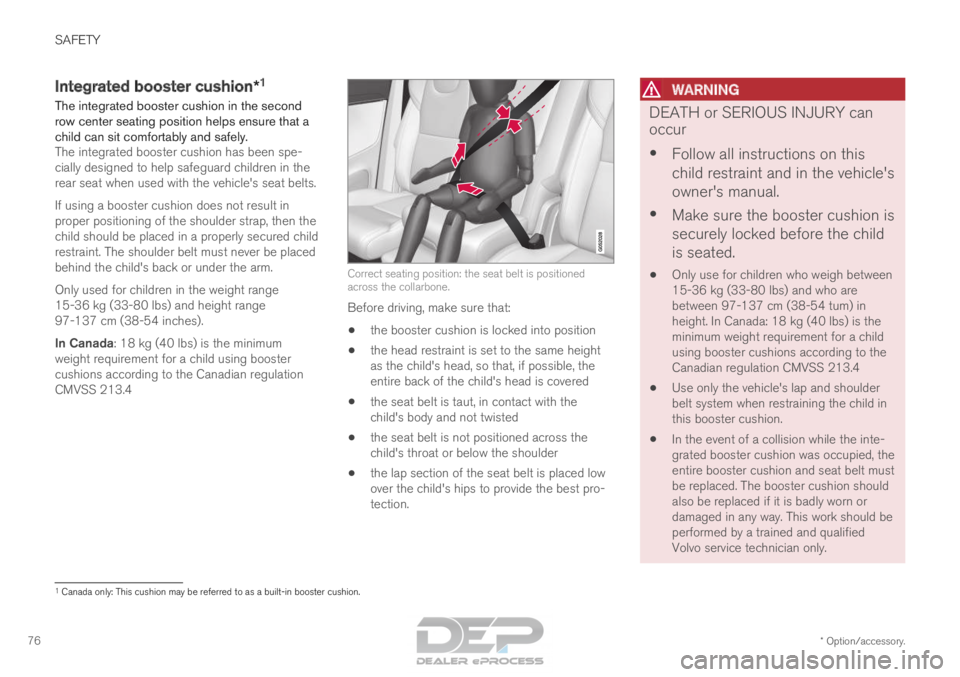
SAFETY
* Option/accessory.
76 Integrated booster cushion*
1
The integrated booster cushion in the second
row center seating position helps ensure that a
child can sit comfortably and safely.
The integrated booster cushion has been spe-
cially designed to help safeguard children in the
rear seat when used with the vehicle's seat belts.
If using a booster cushion does not result in
proper positioning of the shoulder strap, then the
child should be placed in a properly secured child
restraint. The shoulder belt must never be placed
behind the child's back or under the arm.
Only used for children in the weight range
15-36 kg (33-80 lbs) and height range
97-137 cm (38-54 inches).
In Canada: 18 kg (40 lbs) is the minimum
weight requirement for a child using booster
cushions according to the Canadian regulation
CMVSS 213.4 Correct seating position: the seat belt is positioned
across the collarbone.
Before driving, make sure that:
• the booster cushion is locked into position
• the head restraint is set to the same height
as the child's head, so that, if possible, the
entire back of the child's head is covered
• the seat belt is taut, in contact with the
child's body and not twisted
• the seat belt is not positioned across the
child's throat or below the shoulder
• the lap section of the seat belt is placed low
over the child's hips to provide the best pro-
tection.
WARNING DEATH or SERIOUS INJURY can
occur
•
Follow all instructions on this
child restraint and in the vehicle's
owner's manual.
• Make sure the booster cushion is
securely locked before the child
is seated.
• Only use for children who weigh between
15-36 kg (33-80 lbs) and who are
between 97-137 cm (38-54 tum) in
height. In Canada: 18 kg (40 lbs) is the
minimum weight requirement for a child
using booster cushions according to the
Canadian regulation CMVSS 213.4
• Use only the vehicle's lap and shoulder
belt system when restraining the child in
this booster cushion.
• In the event of a collision while the inte-
grated booster cushion was occupied, the
entire booster cushion and seat belt must
be replaced. The booster cushion should
also be replaced if it is badly worn or
damaged in any way. This work should be
performed by a trained and qualified
Volvo service technician only. 1
Canada only: This cushion may be referred to as a built-in booster cushi\
on.
Page 79 of 686

SAFETY
}}
* Option/accessory. 77
Related information
•Child restraints (p. 65)
• Folding up the integrated booster cushion*
(p. 77)
• Folding down the integrated booster cush-
ion* (p. 78) Folding up the integrated booster
cushion*
When the integrated booster cushion is used, it
must be folded up. Pull the handle forward and upward to
release the booster cushion. Press the booster cushion rearward to lock it
into position.
Page 80 of 686

||SAFETY
* Option/accessory.
78
WARNING DEATH or SERIOUS INJURY can
occur
•
Follow all instructions on this
child restraint and in the vehicle's
owner's manual.
• Make sure the booster cushion is
securely locked before the child
is seated.
• Only use for children who weigh between
15-36 kg (33-80 lbs) and who are
between 97-137 cm (38-54 tum) in
height. In Canada: 18 kg (40 lbs) is the
minimum weight requirement for a child
using booster cushions according to the
Canadian regulation CMVSS 213.4
• Use only the vehicle's lap and shoulder
belt system when restraining the child in
this booster cushion.
• In the event of a collision while the inte-
grated booster cushion was occupied, the
entire booster cushion and seat belt must
be replaced. The booster cushion should
also be replaced if it is badly worn or
damaged in any way. This work should be
performed by a trained and qualified
Volvo service technician only.Related information
•
Integrated booster cushion* (p. 76)
• Folding down the integrated booster cush-
ion* (p. 78) Folding down the integrated
booster cushion*
When the integrated booster cushion in the rear
seat is not in use, it should be stowed (folded
down). Pull the handle forward to release the
booster cushion.